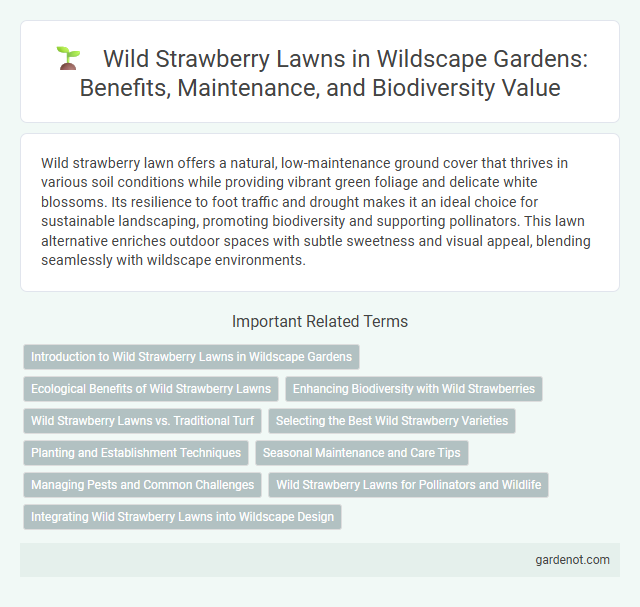Wild strawberry lawn offers a natural, low-maintenance ground cover that thrives in various soil conditions while providing vibrant green foliage and delicate white blossoms. Its resilience to foot traffic and drought makes it an ideal choice for sustainable landscaping, promoting biodiversity and supporting pollinators. This lawn alternative enriches outdoor spaces with subtle sweetness and visual appeal, blending seamlessly with wildscape environments.
Introduction to Wild Strawberry Lawns in Wildscape Gardens
Wild strawberry lawns thrive in Wildscape gardens by combining natural beauty with ecological benefits, offering a low-maintenance alternative to traditional turfgrass. These lawns feature Fragaria vesca, a resilient groundcover that supports pollinators and enhances soil health while providing a soft, edible carpet of tiny berries. Incorporating wild strawberry into landscape design promotes biodiversity and creates sustainable, aesthetically pleasing green spaces.
Ecological Benefits of Wild Strawberry Lawns
Wild strawberry lawns enhance biodiversity by providing a habitat and food source for pollinators like bees and butterflies, boosting local ecosystems. Their deep root systems improve soil structure and increase water retention, reducing erosion and promoting healthier landscapes. These lawns require less mowing and irrigation, contributing to sustainable garden management and lowering environmental impact.
Enhancing Biodiversity with Wild Strawberries
Wild strawberry lawns significantly enhance biodiversity by providing a natural habitat for pollinators such as bees and butterflies, fostering ecological balance in garden ecosystems. Their low-growing, spreading nature supports soil health and prevents erosion while offering a food source for various wildlife species, including birds and small mammals. Integrating wild strawberries into lawns promotes a resilient, thriving environment by encouraging native plant diversity and sustainable garden practices.
Wild Strawberry Lawns vs. Traditional Turf
Wild Strawberry Lawns provide a sustainable, low-maintenance alternative to traditional turf, thriving with less water and fertilizer while supporting pollinators like bees and butterflies. These lawns feature dense, creeping Fragaria vesca that create a soft, natural carpet resistant to drought and foot traffic, unlike conventional grass that often requires frequent mowing and chemical treatments. Wild strawberry lawns enhance biodiversity and soil health, making them ideal for eco-conscious landscaping and reducing environmental impact compared to monoculture turfgrass.
Selecting the Best Wild Strawberry Varieties
Selecting the best wild strawberry varieties for your Wildscape involves choosing species that thrive in your local climate and soil conditions, such as Fragaria vesca for cooler regions and Fragaria virginiana for warmer areas. Prioritize disease-resistant varieties with high fruit yield and vibrant flavor profiles to enhance natural biodiversity and attract pollinators. Incorporating native wild strawberry species promotes ecological balance and supports local wildlife habitats within your Wildscape.
Planting and Establishment Techniques
Wild strawberry lawns require well-drained, sandy or loamy soil with a pH between 5.5 and 7.0 for optimal rooting and growth. Plant runners or plug plants in early spring or late summer, spacing them approximately 12 inches apart to ensure healthy establishment and minimize competition. Maintaining consistent moisture without waterlogging and applying a thin layer of organic mulch enhances root development and supports vigorous growth during the establishment phase.
Seasonal Maintenance and Care Tips
Wild strawberry lawns thrive with consistent seasonal maintenance, including regular mowing at a height of 1.5 to 2 inches to encourage dense growth and prevent weeds. Spring requires light fertilization with a balanced 10-10-10 fertilizer and removal of debris to promote healthy new growth. In summer and fall, monitoring for pests like slugs and ensuring adequate moisture during dry spells supports vibrant foliage and fruit production.
Managing Pests and Common Challenges
Wild strawberry lawns require careful pest management to prevent damage from slugs, aphids, and beetles that commonly feed on their leaves and fruit. Regular monitoring and natural predators like ladybugs can help control aphid populations without the need for chemicals. Ensuring proper soil drainage and avoiding overwatering reduces fungal diseases, while removing weeds early prevents competition for nutrients essential to the health of wild strawberry plants.
Wild Strawberry Lawns for Pollinators and Wildlife
Wild strawberry lawns provide an ideal habitat for pollinators such as bees and butterflies, supporting biodiversity by offering abundant nectar and pollen sources. These low-growing, resilient plants enhance soil health and attract beneficial insects, contributing to a balanced ecosystem. Incorporating wild strawberry into lawns promotes wildlife presence and supports sustainable gardening practices.
Integrating Wild Strawberry Lawns into Wildscape Design
Integrating wild strawberry lawns into wildscape design enhances biodiversity by providing habitat and food sources for pollinators like bees and butterflies. Wild strawberry (Fragaria virginiana) thrives in diverse soil conditions and requires minimal maintenance, promoting sustainable landscaping practices. Its low-growing, ground cover nature reduces soil erosion while creating a visually appealing, fragrant carpet that supports ecological balance.
Wild strawberry lawn Infographic

 gardenot.com
gardenot.com